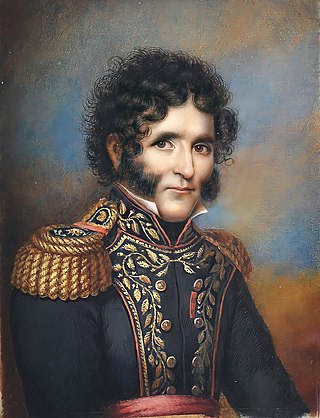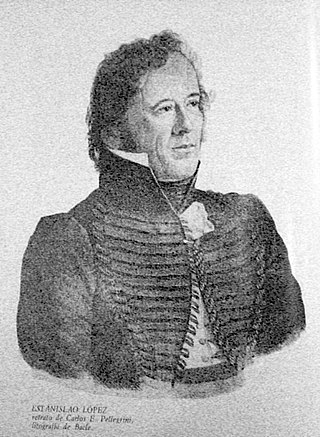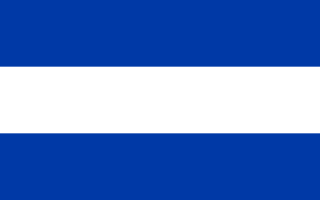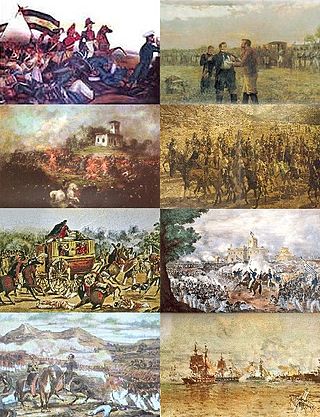The term federalist describes several political beliefs around the world. It may also refer to the concept of parties, whose members or supporters called themselves Federalists.

The Argentine Confederation was the last predecessor state of modern Argentina; its name is still one of the official names of the country according to the Argentine Constitution, Article 35. It was the name of the country from 1831 to 1852, when the provinces were organized as a confederation without a head of state. The governor of Buenos Aires Province managed foreign relations during this time. Under his rule, the Argentine Confederation resisted attacks by Brazil, Bolivia, Uruguay, France and the United Kingdom, as well as other Argentine factions during the Argentine Civil Wars.

The Argentine War of Independence was a secessionist civil war fought from 1810 to 1818 by Argentine patriotic forces under Manuel Belgrano, Juan José Castelli, and José de San Martín against royalist forces loyal to the Spanish crown. On July 9, 1816, an assembly met in San Miguel de Tucumán, declaring independence with provisions for a national constitution.

Juan Facundo Quiroga was an Argentine caudillo who supported federalism at the time when the country was still in formation.

Estanislao López was a caudillo and governor of the province of Santa Fe, Argentina, between 1818 and 1838, one of the foremost proponents of provincial federalism, and an associate of Juan Manuel de Rosas during the Argentine Civil War. He is considered an iconic figure in Santa Fe and one of the most influential political actors in the Argentine conflicts of the 1820s and 1830s.

The United Provinces of the Río de la Plata, earlier known as the United Provinces of South America, was a name adopted in 1816 by the Congress of Tucumán for the region of South America that declared independence in 1816, with the Sovereign Congress taking place in 1813, during the Argentine War of Independence (1810–1818) that began with the May Revolution in 1810. It originally comprised rebellious territories of the former Spanish Viceroyalty of the Río de la Plata dependencies and had Buenos Aires as its capital.

Manuel Dorrego was an Argentine statesman and soldier. He was governor of Buenos Aires in 1820, and then again from 1827 to 1828.

The current Constitution of Argentina dates from 1853. The Constitution of Argentina of 1853 was approved in 1853 by almost all of the provincial governments at that moment with the exception of Buenos Aires Province, which remained separate from the Argentine Confederation until 1859. After several modifications to the original constitution and the return of power to Buenos Aires' Unitarian Party, it was sanctioned in May 1, 1853 by the Constitutional Convention gathered in Santa Fe, and it was promulgated by the provisional director of the national executive government Justo José de Urquiza, a member of the Federalist Party. Following the short-lived constitutions of 1819 and 1826, it was the third constitution in the history of the country.
The Congress of Tucumán was the representative assembly, initially meeting in San Miguel de Tucumán, that declared the independence of the United Provinces of South America on July 9, 1816, from the Spanish Empire.

The Treaty of Pilar was a pact signed among the rulers of the Argentine provinces of Santa Fe, Entre Ríos and Buenos Aires, which is recognized as the foundation of the federal organization of the country. It was signed in the city of Pilar, Buenos Aires on 23 February 1820 by governor Estanislao López for Santa Fe, caudillo Francisco Ramírez for Entre Ríos, and provisional governor Manuel de Sarratea for Buenos Aires, after the dissolution of the national government caused by the Battle of Cepeda. A reference to it was included in the Preamble of the Argentine Constitution of 1853 as one of the "pre-existing pacts" fulfilled by it.

Manuel de Sarratea,, was an Argentine diplomat, politician and soldier. He was the son of Martín de Sarratea (1743–1813), of the richest merchant of Buenos-Aires and Tomasa Josefa de Altolaguirre. His sister Martina de Sarrateas (1772–1805) married Santiago de Liniers, vice-roy del Rio de la Plata.
The Arequito revolt, was a military revolt by officers of the Army of the North through which they recused themselves from the fight in the civil war against the federales. Their intention was to return to the front of the war against the royalists in Upper Peru, an objective that they could not ultimately meet. It signified the beginning of the disintegration of the Supreme Directorship and was one of the main causes of the centralist defeat at the Battle of Cepeda.

The Argentine Civil Wars were a series of civil conflicts of varying intensity that took place through the territories of Argentina from 1814 to 1853. Initiation concurrently with the Argentine War of Independence (1810–1820), the conflict prevented the formation of a stable governing body until the signing of the Argentine Constitution of 1853, followed by low frequency skirmishes that ended with the Federalization of Buenos Aires. The period saw heavy intervention from the Brazilian Empire that fought against state and provinces in multiple wars. Breakaway nations, former territories of the viceroyalty such as the Banda Oriental, Paraguay and the Alto Peru were involved to varying degrees. Foreign powers such as British and French empires put heavy pressure on the fledging nations at times of international war.

The Unitarian League also referred to as the League of the Interior was a league of provinces of Argentina led by José María Paz, established in 1830, aiming to unite the country under unitarian principles. It comprised the provinces of San Luis, La Rioja, Catamarca, Mendoza, San Juan, Tucumán, Córdoba, Salta and Santiago del Estero. It was opposed and ultimately defeated by the provinces of the Federal Pact.
The rise of the Argentine Republic was a process that took place in the first half of the 19th century in Argentina. The Republic has its origins on the territory of the Viceroyalty of the Río de la Plata, a colony of the Spanish Empire. The King of Spain appointed a viceroy to oversee the governance of the colony. The 1810 May Revolution staged a coup d'état and deposed the viceroy and, along with the Argentine war of independence, started a process of rupture with the Spanish monarchy with the creation of an independent republican state. All proposals to organize a local monarchy failed, and no local monarch was ever crowned.

The Argentine War of Independence was fought from 1810 to 1818 by Argentine patriotic forces under Manuel Belgrano, Juan José Castelli and José de San Martín against royalist forces loyal to the Spanish crown. On July 9, 1816, an assembly met in San Miguel de Tucumán, declared full independence with provisions for a national constitution.

The dissolution of the Viceroyalty of the Río de la Plata meant the breakup of the Spanish colony in South America and the creation of new independent countries. Most of the territory of the Spanish viceroyalty is now part of Argentina, and other regions belong to Bolivia, Brazil, Paraguay and Uruguay.

Juan Felipe Ibarra was an Argentine soldier and politician. He was one of the caudillos who dominated the Argentine interior during the formation of the national state, and ruled the province of his birth for decades.

The Decembrist revolution was a military coup in the Buenos Aires Province, Argentina. Juan Lavalle, returning with the troops that fought in the Argentine-Brazilian War, performed a coup on December 1, 1828, capturing and killing the governor Manuel Dorrego and ultimately closing the legislature. The rancher Juan Manuel de Rosas organized militias that fought against Lavalle and removed him from power, restoring the legislature. However, as the coup had reignited the Argentine Civil Wars, Rosas was appointed governor of the Buenos Aires province to wage the war against the Unitarian League. José María Paz made from Córdoba a league of provinces, and so did Rosas. The conflict ended a short time after the unexpected capture of Paz, who mistook enemy troops for his own.

Juan Bautista Bustos was an Argentine politician and military leader who participated in the British invasions of the River Plate and the Argentine Civil Wars. In 1820, he became the first constitutional Governor of Córdoba.















